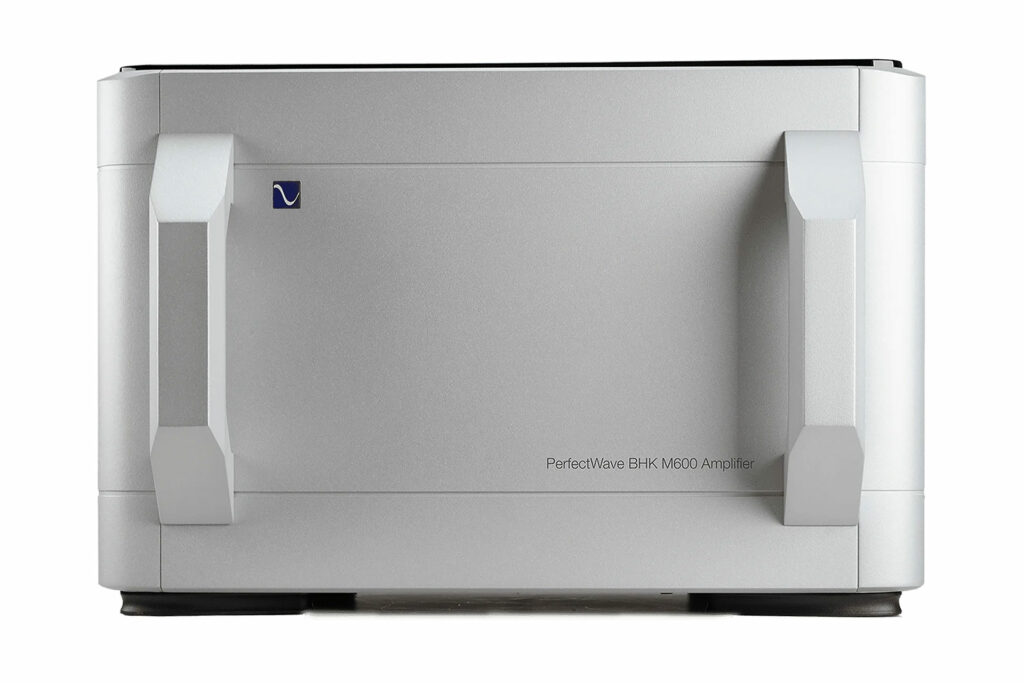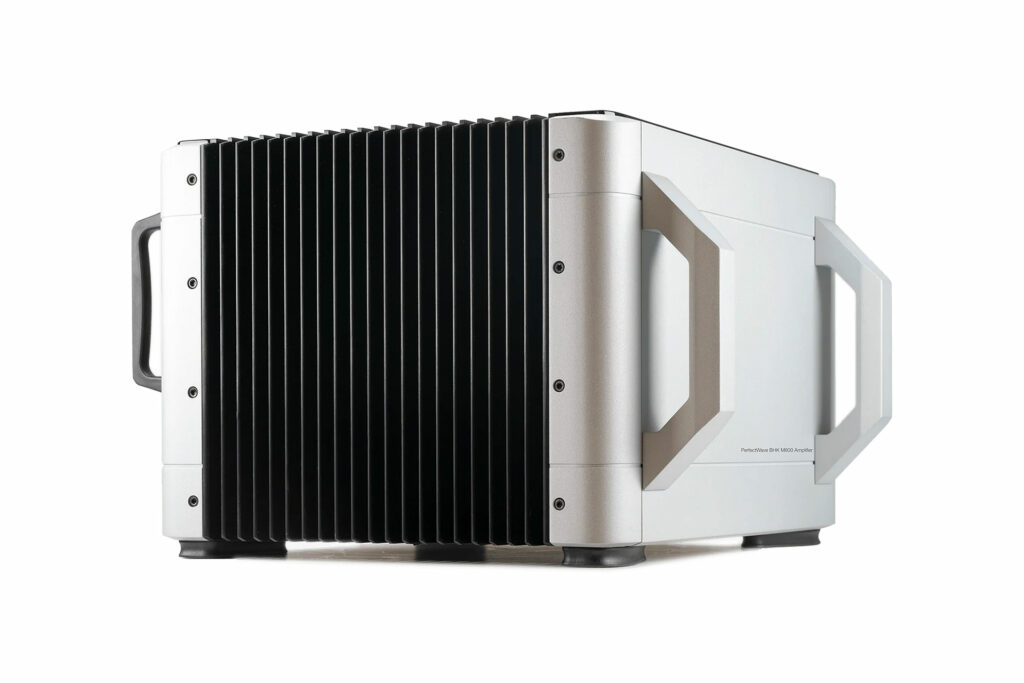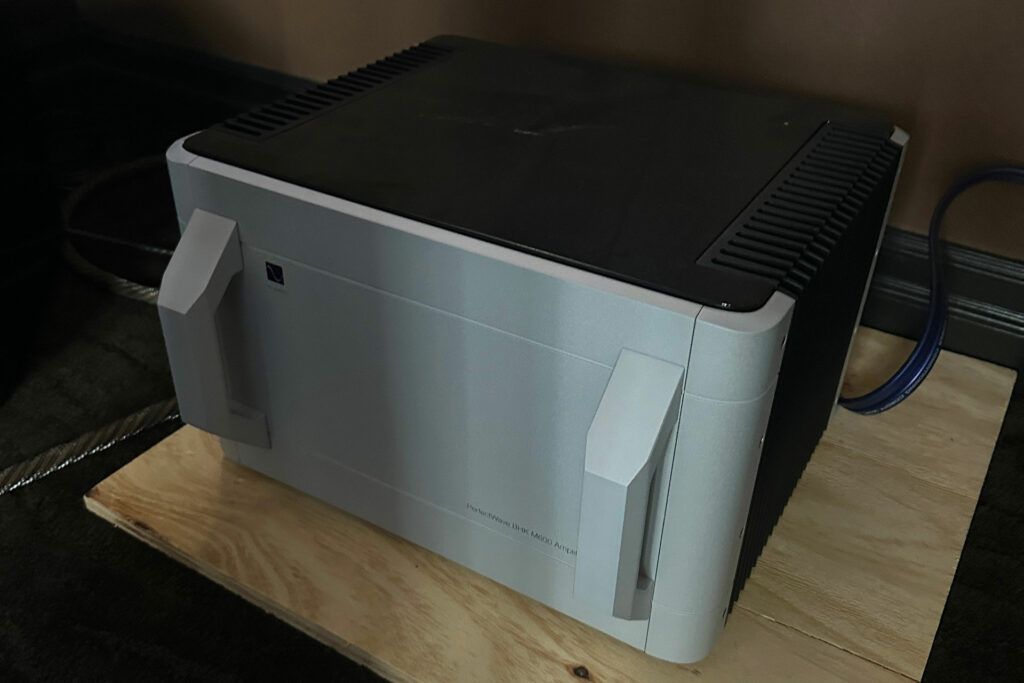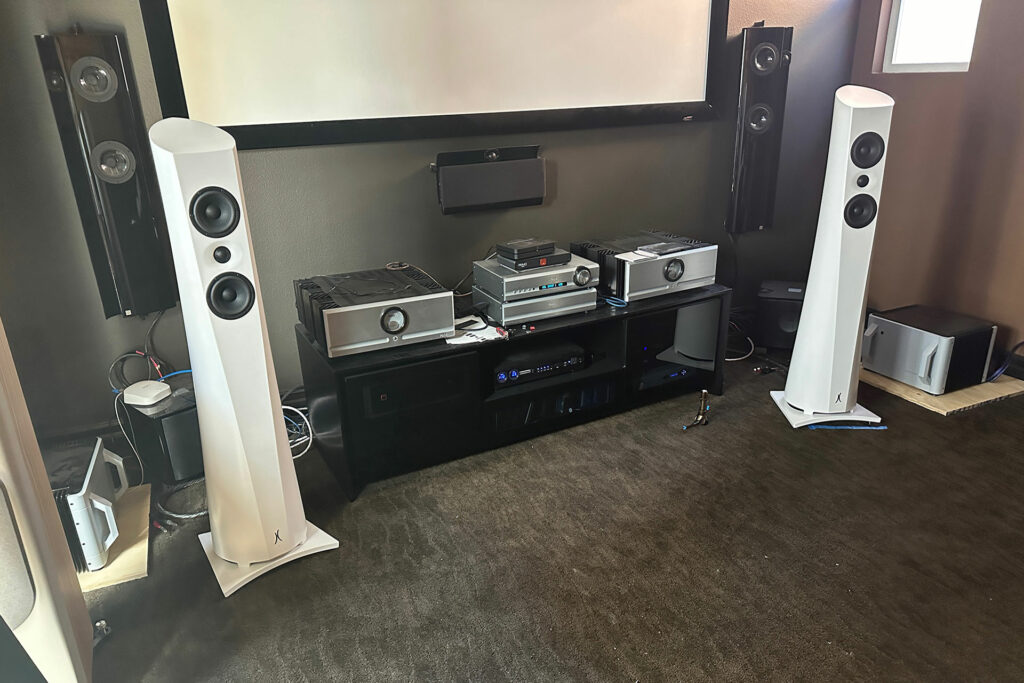PS Audio has evolved over its 50-plus years of business and now manufactures a complete line of high-performance audiophile products designed to reproduce music from digital sources to speakers and everything in between. Their product line starts at the middle level of audio performance (mid-fi) and progresses to the very high end, which is where we land with nearly $30,000 monoblock power amps.
Bascom King, a longtime luminary audio engineer, was commissioned to design a no-expense-spared amplifier. After three years of engineering, the PS Audio BHK Mono 600 Amplifiers were in production, with a retail price of $29,999. PS Audio has come a long way since it moved to a value proposition consumer-direct company, with a 30-day in-home trial. Let’s explore this monumental set of monoblock amplifiers and understand their features, significance, and how they perform in an audiophile world filled with amps at this lofty price.

What Makes the PS Audio BHK Mono 600 Amplifiers So Special?
- The BHK Mono 600 are Class-AB push-pull amplifiers with a hybrid topology design that includes a tube input stage and a solid-state MOSFET transistor output stage in a unique design.
- The vacuum tube input stage of the BHK Mono 600 uses two carefully chosen Genalex Gold Lion 6922 triodes for audio characteristics performance. These user-replaceable tubes are in production today. In fact, the user can roll the tubes, meaning alternative tubes can be used to tailor the sound to your liking. However, PS Audio explains that an extensive sound audition was performed, and the stock Genalex tubes are believed to sound best. Depending on use, these tubes will last from one to two years or longer before audio quality deteriorates. Replacements are easily obtained from PS Audio and other retailers, and will set you back $300 for a set of four.
- A third vacuum tube is part of the rectification design, which converts alternating current (AC) to direct current (DC), and is commonly accomplished by solid-state diodes that can cause noise and ringing in the music signal. Tube rectification is cleaner, quieter, and, according to PS Audio, offers a more spacious and open sound. It is unique in amplifiers at this power level, and is not currently used in PS Audio’s alternative amplifier models. The rectification tube used here is the 6CA4/EZ81, an NOS or new-old stock tube from the ‘80s out of East Germany. NOS means the tube is no longer in production, but there is a large quantity of available stock. This tube should last seven or more years.
- The PS Audio BHK Mono 600 uses N-type MOSFETs for both positive and negative signals in the output stage, which is not a standard design. Typically, P-type MOSFETs are used for the negative signal. Using only N-type positive MOSFETS for positive and negative signals requires specific engineering, which demands heavy-gauge wiring and gold-plated copper bus bars for unrestricted power transfer. This design ultimately allows for an improved electrical waveform.
- The PS Audio BHK Mono 600s boast an enormous 600 watts per channel at eight ohms, 1,200 watts per channel at four ohms, and is stable to two ohms at 2,000 watts. They are monsters at a hefty 108 pounds each.
- To achieve its lofty power specifications, the PS Audio BHK Mono 600 uses a 1.6 KVA power supply, which feeds the 336,000 microfarads of capacitance. Remember, this is for one amplifier and one channel, with the consumer receiving two.
- Fit and finish is first-rate and magnificent on these power amplifiers. The powder coated in silver or black solid aluminum rounded corner facia is stylish, while oversized right and left handles add quality and brawn. Burly heat sinks flank the right and left sides, and are part of the casework structure that fits flush to the front casework. Nothing about this design is off the shelf, but is instead bespoke to this product and purpose-built. Worth noting is the black plexiglass top panel, which may be delicate, but I think if one refrains from putting items on top of the amplifier, it will be fine. I have no idea how PS Audio gets away without ventilation on the top panel, which many other amplifiers have today. However, this is how this amplifier is configured. I know that ventilation exits out the bottom of the amplifier, so the amplifier cannot rest directly on the carpet. It must sit on a hard surface, preferably on an amplifier stand.
- Either XLR balanced or RCA single-ended inputs are offered. Dual speaker outputs allow for easy bi-wiring. Two trigger inputs allow another component, such as a preamplifier, to turn on and off the amplifiers, either directly or in a daisy-chain configuration.
- Selectable gain output levels, 26 dB or 30.5 dB, provide flexibility with various components.
Why Should You Care About the PS Audio BHK Mono 600 Amplifiers?
Over Bascom King’s long career, he collaborated with various companies and other luminary engineers within the industry, such as Infinity Systems with Arnie Nudell, early Marantz designs of the 1960s and 1970s, Conrad Johnson, and Great American Sound (GAS) with the Ampzilla amplifier with James Bongiorno, to name just a few. While King is the sole designer and thrust of the PS Audio BHK Mono 600 amplifier with his ideas on circuits and execution, I am compelled to consider all the years of collaboration with industry peers, many of whom are no longer with us today, leading up to this design and why we should consider the nostalgic legacy the BHK Mono 600 carries with it. As you may know, at 81 and just before the launch of the BHK Mono 600, King passed away. PS Audio should be proud that they took on this project when they did and, in the process, brought to market a significant part of audio history along with it.
Ultimately, though, the amplifier must perform well, regardless of who designed it and the history behind it. While I do not want to get ahead of myself, this amplifier holds up its legacy well.

Some Things You Might Not Like About the PS Audio BHK Mono 600 Amplifiers …
- The PS Audio BHK Mono 600s are really large. With external dimensions of approximately 17 inches wide, 11 inches tall, and 17.5 inches deep, their stature is easy to notice, especially when considering the large front and rear handles and connectors.
- At 108 pounds each, we won’t be moving these amplifiers frequently. Set and forget is the name of this game. One common strategy with amplifiers of this kind is to place each one near or behind the speaker, allowing for a short speaker cable, but with a longer interconnect cable. In this type of installation, you may also get lucky with short power cables. In practice, I can concur this is the most convenient path to follow.
- The BHK Mono 600s run hot, as you might expect with tubes as part of the design. At idle, these amplifiers measured 90 to 93 degrees, and in full operation mode, they rang in at 123 degrees. In a smallish 14 feet by 15 feet room such as mine, with nine-foot ceilings, the room became stuffy fast. Not for the uncommitted, these amplifiers require a significant passion for ownership. It is a serious decision to step into this commitment.
Listening to the PS Audio BHK Mono 600 Amplifiers …
My current reference system is a Pass Labs XP 22 preamplifier, wired to a set of Pass Labs XA60.8 high-current monoblock amplifiers, operating in full Class-A mode up to 60 watts at eight ohms, doubling power at four ohms, and again at two ohms. Focal Kanta No. 2 floorstanding speakerswould be the final stage of my system, creating a highly-resolving platform. The system benefits from Wireworld Eclipse 8 speaker cables, interconnects, and Electra 7 power cables for the amplifiers. As a source, I will use a PS Audio AirLens streamer and StellarGold DAC, which I have had on hand from recent reviews.
I will describe my experience with the PS Audio BHK Mono 600 based on its merits and my perceptions, and I will also compare and relate them to my Pass Labs XA 60.8 monoblock amplifiers. When comparing these two formidable amplifier models, please acknowledge their differences. The BHK Mono has ten times the power (600 watts per channel compared to 60 watts per channel), and costs more than twice as much ($30,000 versus $14,000). Additionally, the BHK is a hybrid design with a tube input section that operates in Class-AB. In contrast, the XA60.8s are 100 percent solid state and operate in full Class-A. Some similarities these two amplifiers share are the advantages of monoblock channel separation and high-current designs: they can roughly double their power output when speaker impedances decrease by half and stable down to two ohms.
Immediately noticeable from the first track, the BHK 600 Mono has an effortless, open, and large dynamic sound that is easy to notice. For example, the song “Crash” by the Dave Matthews Band(Tidal 16-bit, 44.1kHz FLAC) from their 1996 album of the same name has an easily recognizable acoustic guitar introduction riff by Dave Matthews, and some clever cymbal and cowbell instrumentation. It played big with a soundstage that emanated from behind the speakers with a nice wrap around and beyond each Focal Kanta No. 2. The image was crystal clear, with what I would describe as authority. Each instrument had its own three-dimensional image, yet worked well with new instrumentation entering as the song grew in complexity. But my staple Pass Labs XA 60.8s also has those qualities, or does it? With close listening and quick A-B switching, it became clear that the sonic character of the BHK Mono 600s had a little more forthrightness, precision, and a quality of timbre that added an effortless quality to its reproduction. At first, it was hard to parse, since both sounded good and right. However, over time, I could pick up nuances of the differences and, to me, the BHK Mono 600 brought a more realistic rendition when compared to my Pass Labs XA60.8, especially in the bass frequencies.
Further along the same track is an underlying bass line that played with a tighter, controlled shape. Both amplifiers have their rendition of bass; with the BHK 600 Monos, it was tight with definition and control, and with the XA60.8, it was thick and heavy and, in certain situations, could be considered bloated. Class-A biased amplifiers, like the XA60.8, are known for their more pronounced bass quality, which is displayed here. In some situations, it is preferred. In this case, the XA60.8 pushed me back into my seat with that flappable bass line that led to some listener fatigue.
I took the bass issue to the next level with the wildly popular ‘80s Phil Collins track “In The Air Tonight”(Tidal 16-bit, 44.1kHz, FLAC) from his 1981 Face Value album. At about 3:40 into the track, the song shifts quickly with its familiar loud, hard-hitting drum solo that everyone has heard. The song took on a new presentation with the BHK Mono 600, demonstrating an extensive, detailed, defined bass percussion solo. Switching to the XA60.8 was a less compelling performance, but still energized – the XA60.8s are no slouches.
One advantage of having so much power, and power in reserve, is the ability to keep up with significant, fast changes in volume demand, as with this track. When the volume level bumps up, the wattage demand increases exponentially to hundreds of watts, if not a thousand watts, in microseconds. With the BHK Mono 600’s power, it has an advantage, which was apparent here.
Alternatively, I could hear the XA60.8 had an ever so slight advantage with an overall detail in the upper frequencies. For example, on the song “Gypsy” by Fleetwood Mac (Tidal 24-bit, 192kHz FLAC), from their 1982 Mirage album, at around 2:30 into the track and continuing into the song, the XA60.8 reveals an ever so slight high-frequency cymbal projecting from the stage’s right side, which I interpret as Stevie Nicks lightly moving her tambourine. With the BHK 600 Monos, at that exact point in the track, that tambourine is present, but less obvious and easily unnoticed. The difference is slight, but real. However, the PS Audio BHK 600s displayed clarity and concise upper frequencies in an airy, effortless way, even with its more subtle ultra-upper frequencies.
Another Dave Matthews Band song, “What Would You Say” (Qobuz 16-bit, 44.1kHz Flac), from their Under the Table and Dreaming album, is a magical compilation of sheer genius. Dave Matthews’ guitar intro and some amazing harmonica riffs are at the intro. Once again, this demonstrates the three-dimensionality of the instrument with air and decay, with a quality about it that just makes you shake your head in disbelief. At about 2:20 into the track, a three-part improvisation leading off with Matthews’ virtuoso acoustic guitar, followed by Leroi Moore’s saxophone, and then cemented by Boyd Tinsley’s violin played like a fiddle. I have to admit I was not sure what that third instrument was, so I was compelled to look at the video, which shows the violin at that part of the song; it is not in sync with what is audibly playing, but I will have to go with what I see for this. The fact that I cannot identify the instrument is not a reflection of the audio system, but rather how the instrument is played or recorded. Maybe, in this section, it is an electric violin. Regardless, the improvisation is stellar, with a live sensation that I sank into. The saxophone detail and texture are off the charts, and demonstrate the midrange sophistication of the BHK Mono 600.
I played through many more tracks with similar results, reimagining each song with effortless upper frequencies, midrange detail, and authoritative controlled bass.
Will the PS Audio BHK Mono 600 Amplifiers Hold their Value?
The BHK Mono 600 Amplifiers are a “cry once, buy once” purchase of a lifetime. They come with some serious pedigree and all the power you could want, with lustful performance. If PS Audio decided to stop manufacturing the design, I could see the amplifier holding its value quite well, and perhaps becoming difficult to procure on the secondary market. While the PS Audio BHK Mono 600s are still in production, I expect normal audio depreciation.

What is the Competition for the PS Audio BHK Mono 600 Amplifiers?
There are plenty of monoblock amplifiers at this price point and higher. Many manufacturers want to be in this sandbox, as demonstrated by products from Constellation Audio, McIntosh, CH Precision, Solution, Pass Labs, etc. The list goes on and on, as there is no shortage of companies that want to show off their engineering prowess with their secret sauce to share with would-be audiophiles looking for the next Holy Grail. Here are a few relevant choices.
I mentioned early on in this review that my Pass Labs XA60.8 monoblock amplifiers, with a retail price of $14,250 per pair, were not a fair direct comparison to the BHK Mono 600s. But this does not mean that Pass Labs does not offer more competitive alternatives and, since I used them as my guinea pig in this review, it is only fair to point out a couple of Pass Labs offerings that are important to consider.
First, there are the X600.8 monoblocks at $28,600 per pair. With a similar topology to the BHK Mono 600, with Class-AB bias and a high-current design starting at 600 watts per channel at eight ohms, doubling power as impedance decreases by half, and stable to two ohms, the X600.8 lines up nicely to the BHK Mono 600, not only in specifications, but in price as well. I wish I had the opportunity to compare these two amplifiers directly.
The second Pass Labs amplifier to consider is the XA160.8, retailing for $28,600. At 160 watts per channel, the XA160.8 is not as powerful as the BHK Mono 600, but gets closer compared to my XA60.8 while maintaining full Class-A operation. For those who believe in the magic of Class-A operation, this model is a more relevant comparison to the BHK Mono 600.
The T+A A HV 3000 stereo amplifier, made in Germany, is the company’s top of the line amplifier, with a retail cost of $22,000. With a power rating of 300 watts per channel at eight ohms and 500 watts per channel at four ohms, it may appear less potent than the BHK Mono 600. However, this modular amplifier allows future system-building, since the HV 3000 can be bridged into mono at double the power. Additionally, the amplifier operates in Class-A for the first 40 watts in stereo operation and doubles in mono mode. Two A HV 3000s would bring the cost to $44,000. Additionally, the PS 3000 HV external power supply uses the Power Link connection of the amplifier to power the output stage with additional power and increased reserve. These features allow incremental system-building as your journey grows, which is very cool.
CH Precision is another European brand, and their M1.1 stereo amplifier, which has a retail price of $57,000, is well over the price point of the BHK Mono 600. It has a ton of flexibility to control and customize the amplifier to your needs and system components. Like the T+A, the amplifier can be bridged to grow your system as needed. You can read the full review at the link above.

Final Thoughts on The PS Audio BHK Mono 600 Amplifiers …
The PS Audio BHK Mono 600 amplifiers proved to be a noticeable addition to my system, showing off its capabilities of effortless amplification, offering an extensive and detailed sound with impressive natural timbre. Yet, I could not help but develop the feeling that I was underutilizing the amplifiers with the speakers I had on hand. Although the Focal Kanta No. 2s are venerable speakers and could take advantage of what the BHK Mono 600s offered, it became apparent they could only take me so far with such a capable amplifier. The same could be said for the XA60.8s as well. There was more room to run. It is often said that speakers have the most profound impact on an audio system; therefore, they account for 50 percent to 70 percent of the budget. Given what I experienced here, I unequivocally agree. A more full-range speaker capable of the deepest bass notes would make the BHK Mono 600 feel at home. With that said, speakers at the price point of 30k and up would not be out of the question. On that note, if it were within the budget to step up amplifiers, the PS Audio BHK Mono 600 would be at the top of my contenders list.




This Greg Handy review of the PS Audio amps is very well done; another exceptional product from a classic and highly respected designer. The team at T+A particularly appreciate seeing Greg’s inclusion of our reference T+A A3000 HV amplifier as a point of comparison. Thanks for this! It should be noted, however, that the ability to make each A 3000 into a mono amp does not utilize bridging technology. For many years, T+A built amps that could be bridged, but in more recent products, we have moved away from bridging due to certain problems with speaker loading and stability that always result from a bridged circuit. The A 3000 can be configured as a mono amp by paralleling the outputs of both R & L channels——which increases the output power by a relatively modest amount, but doubles the current delivery into any speaker load, making a very clear and obvious improvement in dynamics, control, and bass authority. This is something we feel is more meaningful for real world applications, and has proven to be consistently superior to our former approach using bridging techniques.
No need to make a change in the review, but we try to read your content carefully, and thought it would be important to help you and your readers understand what we are doing, as well as what we have chosen not to do in our current designs.
Thanks for all you are doing—it is important!
WOW – thanks for adding this Jim.
And always good to hear from you. 🙂
Not sure the mid-fi is a bad word but not one I would personally use in talking about a $30,000 pair of monoblocks. That ain’t mid-fi in my world. That’s very high end. 🙂
I previously reviewed and am currently using the A300HV and the P3100HV in my system and I am pleased and also amazed at the performance of these two components. Extremely well designed, meticulously well built, sonically exceptional and competes across the board with other brands with a much higher retail cost, I cannot find much in the way of fault with the T+A HV series of products. Even the SD3100 Streaming DAC I reviewed was among the best DACs I have had in my system.
I appreciate the clarification. I’m sorry for my lack of proper description. I also should have explained how the T+A A HV3000 (and all components in the HV line) operate at a higher DC Voltage than typical audio components. This amplifier has a few unique topologies that make it very special. If I only had the opportunity to hear it first hand….. On that note, I should have included the T+A M 40 HV.
The term mid-fi has terrible and frankly inapt connotations. I’d stop using it if I were Future Audiophile.
I don’t see Mid-fi as a negative but merely where a piece falls in the market. Greg used the term to point out how broad the PS Audio line has become. PS Audio offers more affordable gear like the Z series up to the BHK. When I read the article, I didn’t get anything negative intended at all. Greg was expressing where PS Audio offerings begin.
Bryan Hudson has excellent reading comprehension. He gets an A+.
The Audio Research 160M did cost around $30k a pair. Although a complete tube amp it would make for an interesting listening comparison with the BHK..